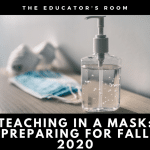Preparing for this coming school year is a daunting task. This past spring was challenging. Many teachers were reminded just why we teach in the classroom, and not online. And while it may seem to be too early to be talking about back to school, I know I can’t be the only teacher who is wondering, “What is the fall going to look like? What do I need to be preparing for?”
Some Things to Consider
One big concern with returning to school in the fall is being able to maintain social distancing. How can schools ensure the safety of students and staff in that regard? A German cafe has been making customers wear hats with pool noddles on top, while a school in China had students make and wear hats with meter-wide wings. Both create that social distance bubble. Could something like this work in the United States? Is watching for pool noddle jousting in the halls something we need to be preparing for?
There is some concern that, even with something like this in place, there is just not enough room in many schools. Some schools are looking at a hybrid model, which combines in-class and online learning. In Colorado, the ratio of online to in-class will depend on the individual communities’ needs. Some districts will be more focused on online learning. Others will stagger students between the two, while some will alternate different groups of students.
It looks like a similar model is being adopted in other states. Michigan and Washington have released their plans for the fall, while districts in Idaho had to have a plan in place. Many of these plans also follow the hybrid model.
Preparing for Hybrid Teaching
At the end of this school year, teachers had to act quickly and transition all of our assignments to an online format. There were also many districts that held students harmless for missed assignments. This was for a variety of reasons, mainly technology related. As we all know, there were many issues with the online format. For educators, there were a lot of things to work out.
As we learned how to Zoom and relied on Google Classroom in a new way, teachers made changes to our existing lessons. We were able to adapt our lessons to a digital format. By the end, most of us felt pretty okay about what we were doing. Looking forward, the hybrid teaching will allow us to take the things we already learned in the spring and add it to what we were already doing. In Connecticut, hybrid schooling means that some classes will be totally online, while others will be a mix. This model is looking like it will quickly become the norm in education. At least in the fall.
Hybrid Advantages
The Hybrid Model will also address the concerns that many teachers have about effectively being able to teach. It can be very difficult to know that students understand something when you are not face-to-face. Being able to have time in the classroom will allow for that conversation to happen. It will also keep students more accountable when it comes to doing their work. In the spring, many students checked out, knowing that they were not going to be penalized for any assignments due after schools were shut down due to COVID-19. The Hybrid Model would help minimize that.
Hybrid teaching also addresses the safety concerns of returning to school in the fall. Not only are there a large number of parents who might continue to educate their children at home otherwise, but there are also teachers who are uncomfortable returning to school. Schools spread disease quickly. Using a mix of online and in-class learning allows for that interaction, but keeps class-sizes smaller. This, in turn, allows for more effective social distancing.
However, there are many people in schools, staff, students, and parents, who are nervous about returning to the classroom at all. For some, they have health issues that make them a prime target for COVID-19. Others worry about student’s ability to social distance within the schools. Could we effectively enforce that?
Preparing for the Future
What will the fall look like? It will probably be very different from last fall. Some things, like masks, hand sanitizer, temperature checks, and fewer large student gatherings will be present for sure. But is that all? Will students be wearing masks and pool noddle hats? Will teachers be wearing masks and pool noddle hats? Can we shuffle the schedules of our students so that they get some time in the classroom, or is that dangerous for them and us?
While states and districts are making plans, it is all so up in the air right now. In New York City, the Department of Education created a survey with several options. This allowed them to see what their students and teachers needed from them in the fall. Then, they can plan accordingly. Many districts had their teachers draft a plan, while others did not.
Maybe the best way to prepare is to remember the lessons that we learned this spring. We can continue to refine those virtual learning practices while acknowledging that some of us wanted to throw them into a volcano. And, of course, we have to remember our roots in the classroom. With luck and some good summer social distancing, we’ll be able to do a little of both in the fall.






